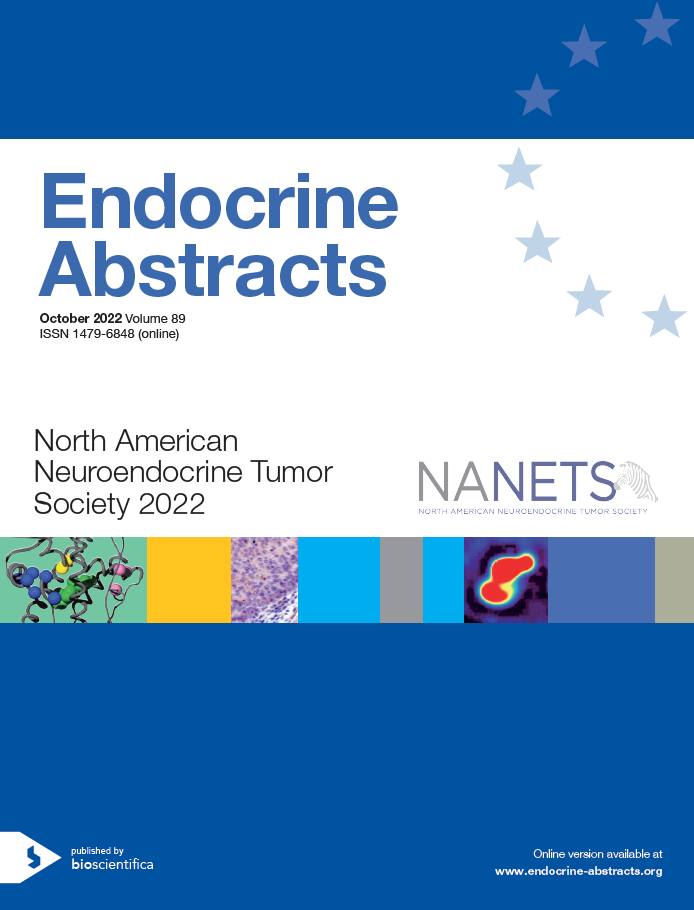15th Annual Multidisciplinary NET Medical Symposium NANETS 2022
Clinical – Nuclear Medicine/Interventional Radiology/Imaging
ea0089c14 | Clinical – Nuclear Medicine/Interventional Radiology/Imaging | NANETS2022
Cardiac Neuroendocrine Tumor Metastases on 68Ga-DOTATATE PET/CT
Lee Hwan , Patel Vandan , Bhattaru Abhijit , Jean Christopher , Pryma Daniel A , Bravo Paco E
ea0089c15 | Clinical – Nuclear Medicine/Interventional Radiology/Imaging | NANETS2022
Effectiveness and Safety of Re-Treatment With 177Lu-DOTATATE in Patients With Progressive NETs in the US: a Retrospective Real-World Study
Delpassand Ebrahim , Mohammadi Yazdi Soheil , Ghantoji Shashank , Reis Nakasato Antonio , Denise Strickland Corinne , Nunez Rodolfo , Shafie Afshin , Cork Susan , Byrne Clare , Tang Jackson , Runeckles Kyle , Patel Jeetvan
ea0089c16 | Clinical – Nuclear Medicine/Interventional Radiology/Imaging | NANETS2022
Clinical Utility of Somatostatin Receptor Positron Emission Tomography Imaging Biomarkers for Characterization of Meningioma Among Incidental Central Nervous System Lesions
Fortin Ensign, MD, PhD Shannon , Agarwal, MD Muskan , Klanderman, PhD Molly , Badawy, MB, BCh Mohamed , Halfdanarson, MD Thorvardur R. , Johnson, MD Derek R. , Bassam Sonbol, MD Mohamad , Kendi, MD Ayse T.
ea0089c17 | Clinical – Nuclear Medicine/Interventional Radiology/Imaging | NANETS2022
Integration of Radioembolization with CapTem for Liver-Dominant G2 NETs: Long-Term Outcomes
Soulen Michael C. , Teitelbaum Ursina R. , Mick Rosemarie , Eads Jennifer , Mondschein Jeffrey I. , Dagli Mandeep , van Houten Diana , Damjanov Nevena , Schneider Charles , Cengel Keith , Metz David C.
ea0089c18 | Clinical – Nuclear Medicine/Interventional Radiology/Imaging | NANETS2022
Radiosensitization for TARE: Does Duration of Chemotherapy Affect PFS?List of participants and their roles in the submission
Soulen Michael C. , Teitelbaum Ursina R. , Mick Rosemarie , Eads Jennifer , Mondschein Jeffrey I. , Dagli Mandeep , van Houten Diana , Damjanov Nevena , Schneider Charles , Cengel Keith , Metz David C.
ea0089c19 | Clinical – Nuclear Medicine/Interventional Radiology/Imaging | NANETS2022
Transformation of G1-G2 Neuroendocrine Tumors (NETs) to Neuroendocrine Carcinomas (NECs) Following Peptide Receptor Radionuclide Therapy (PRRT): a Case Series
Cordero-Hernandez Igryl S. , Ross Alicia C. , Dasari Arvind , Halperin Daniel M. , Chasen Beth , Yao James C.
ea0089c20 | Clinical – Nuclear Medicine/Interventional Radiology/Imaging | NANETS2022
Quality of Life Assessments for Advanced Pheochromocytoma and Paraganglioma Patients that Received High-Specific-Activity I-131 MIBG: Results from a Pivotal Phase 2 Clinical Trial
Jimenez, MD Camilo , Stambler, DrPH Nancy , DiPippo, PhD Vincen A. , Pryma, MD Daniel A.
ea0089c21 | Clinical – Nuclear Medicine/Interventional Radiology/Imaging | NANETS2022
Characterizing Bone Metastases in Patients with Well-Differentiated Neuroendocrine Neoplasms Utilizing Ga68-DOTATATE PET
Coston, MD Tucker W. , Mahadevia, MBBS Himil J. , Plante, MD Marie M. , Accurso, MD Joseph M. , Sharma, MD, MBA Akash , Johnson, MD, PhD Geoffrey B. , Ashman, MD, PhD Jonathan B. , Tuba Kendi, MD Ayse , Bassam Sonbol, MD Mohamad , Hobday, MD Timothy J. , Halfdanarson, MD Thorvardur R. , Starr, DO Jason S.
ea0089c22 | Clinical – Nuclear Medicine/Interventional Radiology/Imaging | NANETS2022
The Role of 68Ga-DOTATATE PET/CT in the Management of Gastrointestinal and Pancreatic Neuroendocrine Tumors
Prela MD Orjola , Caveney BS Brennen , Carpizo MD, PhD Darren R
ea0089c23 | Clinical – Nuclear Medicine/Interventional Radiology/Imaging | NANETS2022
Somatostatin receptor expression in lung neuroendocrine tumors: an analysis of Dotatate PET scans
Al-Toubah, MPH Taymeyah , Pelle, MD Eleonora , El-Haddad, MD Ghassan , Strosberg, MD Jonathan
ea0089c24 | Clinical – Nuclear Medicine/Interventional Radiology/Imaging | NANETS2022
MIBG and DOTATATE Therapy for Pheochromocytoma and Paraganglioma: A Single Institution Experience
Mittra Erik , Mallak Nadine , Pegna Guillaume , Chen Emerson , Lim James , Pommier Rodney
ea0089c25 | Clinical – Nuclear Medicine/Interventional Radiology/Imaging | NANETS2022
Evaluation of 68Ga-DOTATATE PET After Two Cycles of Peptide Receptor Radionuclide Therapy (PRRT) in Neuroendocrine Tumors (NET)
Heying Duan , Hong Song , Valentina Ferri , George Fisher , Shagufta Shaheen , Jagruti Sha , Judy Nguyen , Farshad Moradi , Ben Franc , Guido Davidzon , Andrei Iagaru , Aparici Carina Mari
ea0089c26 | Clinical – Nuclear Medicine/Interventional Radiology/Imaging | NANETS2022
Pre-therapy Functional Imaging with MIBG and DOTATATE to Guide Radiopharmaceutical Therapy for Pheochromocytoma and Paraganglioma: A Single Institution Experience
Mallak Nadine , Szidonya Laszlo , Pegna Guillaume , Pommier Rodney , Mittra Erik
ea0089c27 | Clinical – Nuclear Medicine/Interventional Radiology/Imaging | NANETS2022
Performance of 68Ga-DOTATATE PET/CT, 18F-FDG PET/CT, CT, and MRI Spine in the Detection of Spinal Bone Metastases in Metastatic Pheochromocytoma/Paraganglioma
Jha Abhishek , Patel Mayank , Saboury Babak , Millo Corina , Ling Alexander , Shah Ritu , Chen Clara C. , Meuter Leah , Talvacchio Sara , Knue Marianne , Lin Frank I. , O'Sullivan Coyne Geraldine , Chen Alice P. , Nilubol Naris , Herscovitch Peter , Taieb David , Cahid Civelek Ali , Carrasquillo Jorge A. , Pacak Karel
ea0089c28 | Clinical – Nuclear Medicine/Interventional Radiology/Imaging | NANETS2022
Diagnostic Performance of PET or PET/CT Utilizing 18F-DOPA, 68Ga-DOTATATE, 18F-FDG, 18F-FDA, and CT and MRI in the Detection of MEN2A-related-pheochromocytoma
Jha Abhishek , Patel Mayank , Ling Alexander , Chen Clara C. , Millo Corina , Charles Kailah , Talvacchio Sara , Ezemobi Josephine , Herscovitch Peter , Lin Frank I. , Nilubol Naris , Taieb David , Cahid Civelek Ali , Carrasquillo Jorge , Pacak Karel
ea0089c29 | Clinical – Nuclear Medicine/Interventional Radiology/Imaging | NANETS2022
Diagnostic Performance of PET or PET/CT Utilizing 18F-DOPA, 68Ga-DOTATATE, 18F-FDG, 18F-FDA, and CT and MRI the Detection of VHL-related Pheochromocytoma
Jha Abhishek , Patel Mayank , Ling Alexander , Chen Clara C. , Millo Corina , Charles Kailah , Talvacchio Sara , Ezemobi Josephine , Herscovitch Peter , Lin Frank I. , Nilubol Naris , Taieb David , Cahid Civelek Ali , Carrasquillo Jorge , Pacak Karel




